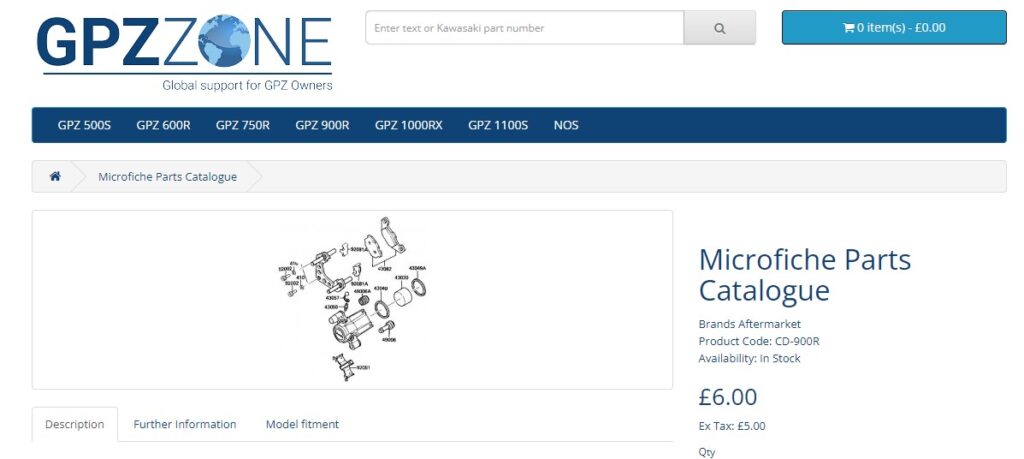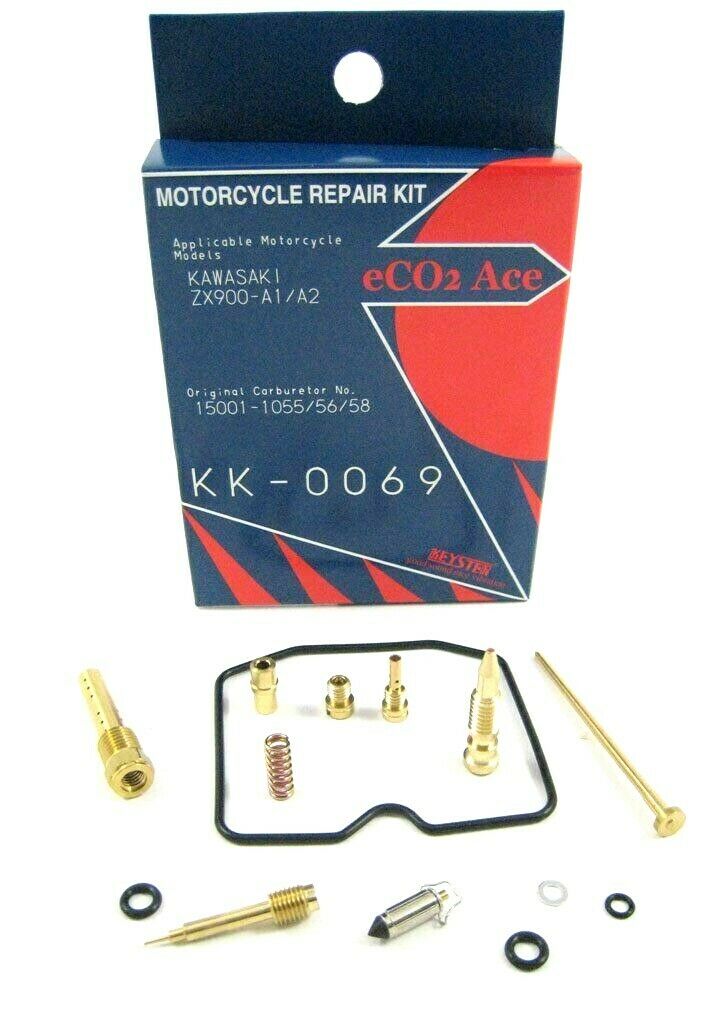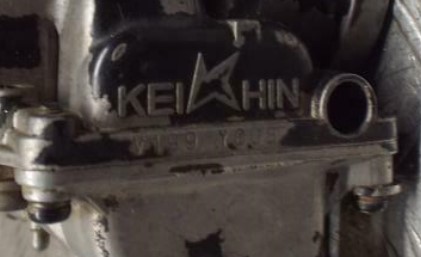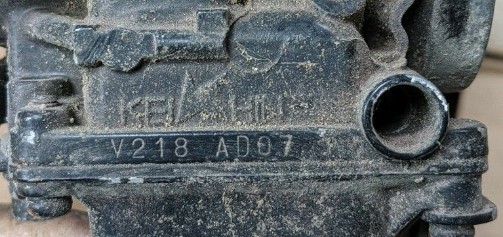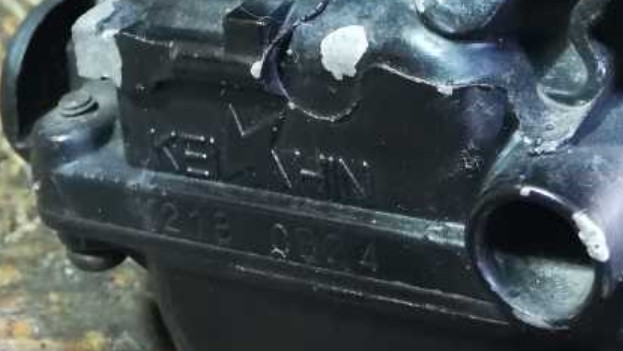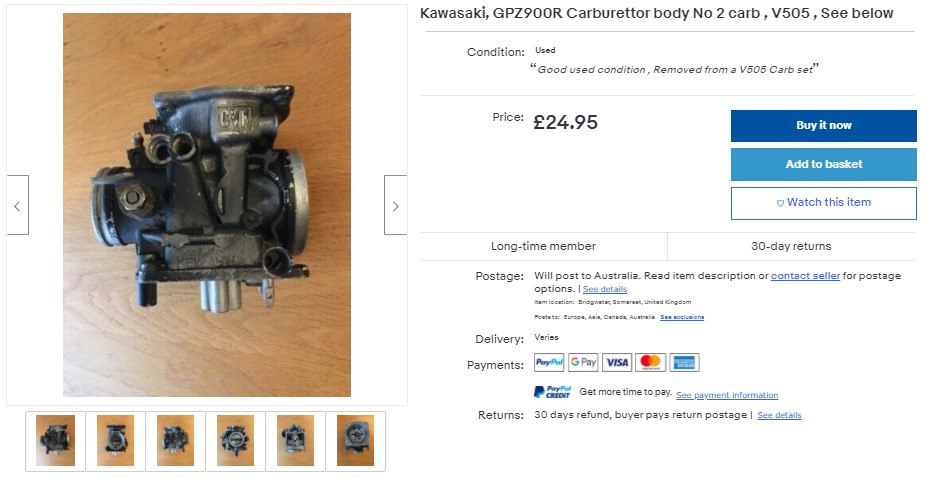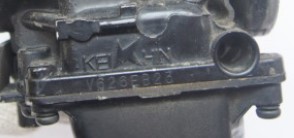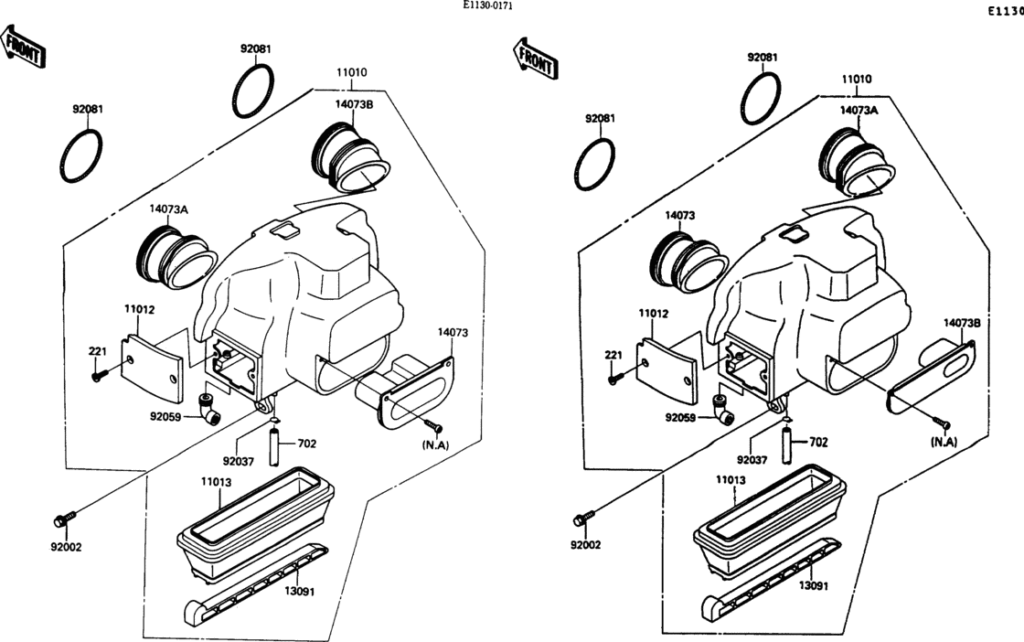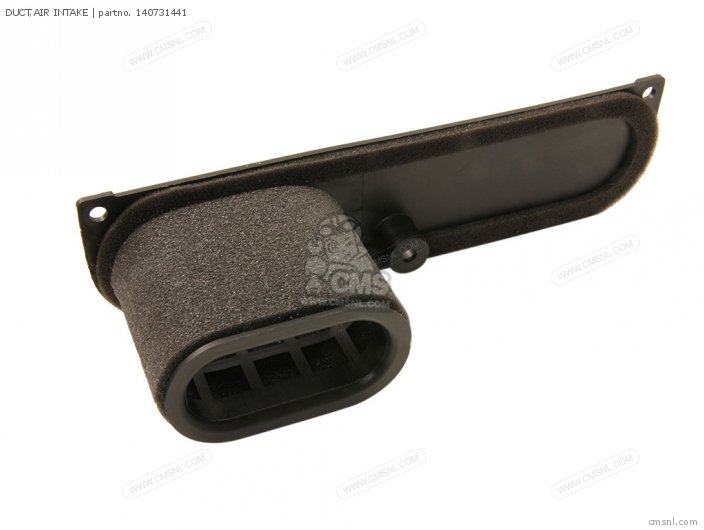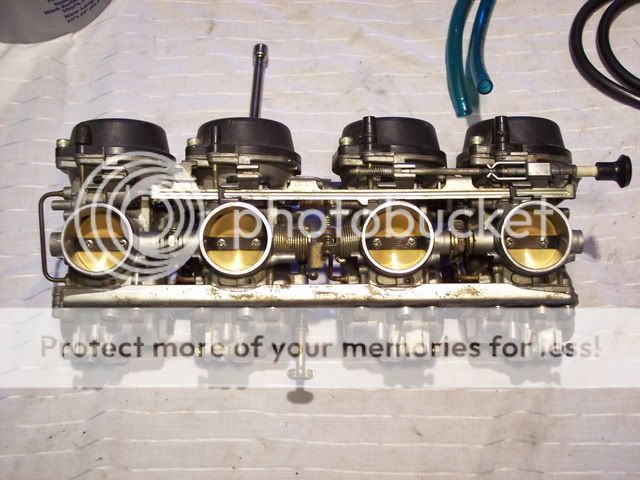Resources
Carburetors (& Airbox)
Technical Discussion Page
Behind the engine of the GPz900R is a bank of four Keihin CVK34 (constant velocity) carburetors, one for each cylinder. Whilst old-school now these were a brand-new, semi flat-slide design developed from the race bikes and I’ve read was another new part created for the release of the GPz900R. In 1988/89 there was another Australian model released with smaller CVK32’s.
A common long rectangular airbox sits behind the carburetors with a rearward facing air intakes (not seen externally) and filter access from the side. This design provides very short & straight airflow paths directly into the engine, however it also means access is difficult and even with the fuel tank removed the central spine of the frame impedes easy access from above. Rubber ducts connect these components, as these age they harden & lose flexibility often making re-assembly nearly impossible without new rubber between the airbox and the carbs.
Interestingly Kawasaki had already installed a Bosch-derived Nissan fuel injection into the 1981 GPZ1100, however it was still developing new expensive technology and obviously wasn’t considered as appropriate nor as well resolved (ie powerful me thinks!) as carburetor setups in 1984. The push for FI at that time seems to have been driven by the auto industry and was most likely due to the simplicity of servicing and the emissions laws that were beginning to appear at that time. As usual FortNine has a quirky look at this! History suggests it was only with the 1996 Ducati 916 that FI really became significantly better and the system of choice for performance bikes.
CV carbs are a particularly elegant solution & work extremely well with the bike, and with minor re-jetting they are more than suitable for most performance increases (eg headers) that you make for the road.
Heres an interesting on the big difference simply using *later* Keihin CV carbs made to a Katana.
Performance gains are there to be extracted (pun intended) and learning how to rebuild & set-up your carbs will be a valuable skill that can potentially save you hundreds of dollars. But as for most multi-carb setups they can be complex to tune properly especially as they age. As there is no direct relationship between the throttle and the slide (see video below for explanation) identifying poor running due to component failure (eg. vacuum leak) OR incorrect set-up likely requires both familiarisation, equipment & expertise.
For the GPz900R Kawasaki used many different carb assemblies, with different needles, jets, slides, caps, jets, etc. The CVK32 was unique to Australia and some European countries had horsepower limits that are reflected in the carb specifications. The carb assembly part numbers changed for all 2nd generation bikes, and with smaller main jets & the restricted airbox intake it is likely that these are part of the reason why these bikes have a lower max HP than 1st gen bikes.
Update: Given the release date of the CVK32 bikes, I wonder if they weren’t a different fuelling trial by Kawasaki? No proof but it makes sense, especially the Australian riding season is 6 months ahead of Europe or the US, and our racing was often used to test brand spanking new Japanese machinery. So I’m thinking perhaps they thought this might be the carbs for the 2nd generation “touring” bikes, but in the end just used different CVK34 setups.
Problems
Some markets had issues with carburetor icing, this is an interesting article to show it isn’t just cold ones where this is an issue. This was enough for Kawasaki to release the extremely rare A5A version, with seemingly the only difference to the standard A5 being extra plumbing to route coolant around the carbs to keep them warm and cosy. I had wondered if there this version also had specific colours but I haven’t been able to confirm this.
Perhaps the strangest part of the A5A is why it is a unique version, after all Australia has a bike with completely different carbs (CVK32) yet we didn’t get our own version……violin playing – lol!
However apart from icing the carbs have very little known issues (compared to other carbs) aside from being extremely difficult to access, remove & install. Whilst I’ve heard that you should get them regularly tuned I’ve been slack and as of Jan 2022 had my A8 for 8 years and over 40,000kms and haven’t touched the carbs at all. Still starts and runs fine.
Twisted Diaphragms
A rare problem was with early 1984 bikes where the slide diaphragm could twist. It was so rare that there is often heated discussion on this!
Bradley B. If you pulled the sliders out of the carbs wrapped your hand around the white plastic “ washer” and then grab the metal slider itself then twisted it, it was loose, it shouldn’t have been, on acceleration the diaphragm would twist pulling the sliders up the “ wings” wouldn’t come back down and it idled badly. As soon as you unscrewed the top of the carb the diaphragms would release and the sliders would drop back down. Ride it for a bit then happened again. Took me ages to work it out, my bike was brand new. August 84, I bought it, the recall ( from what I was told ) was November 84. I fixed it myself after speaking to, it was over 20yrs ago, Les Marshal, could be wrong but I rang Kawasaki in Sydney and that’s what I was told. I had that much trouble with it that I put Mikini smooth bores on it, big mistake. I sold them bought another pair of carbs and had the same problem, that’s when I rang Sydney, not even where I bought it from knew about the problem. I fixed them and never had a problem again.
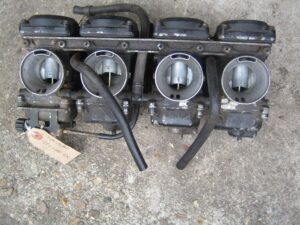
This diagnosis for this set of 15001-1058 A1/2 (Cn) carbs is a twisted diaphragm on #2.
Hydro-lock
An issue with many bikes that ‘upgraded’ from a manual petcock to an ‘auto’ vacuum fuel shut-off. The bike has a vacuum switched cut-off in the petcock but what if this fails? Yes there are shut-off valves in the floats, but because the Keihins do not have an overflow if there is a failure here as well then that means the possibility of fuel in the cylinder. I have a complete write-up on hydro-lock here.
Part Numbers
From official Kawasaki part numbers it show different carb assemblies used for different versions, models and markets. Assemblies had a mixture of unique or common parts, and although many parts have are no longer available but in most case can be replaced.
Part Number Analysis
Megazip Carb Assembly & Component Part Numbers
Whilst you can get the schematics directly from Kawasaki they only show bikes from 1984-87. Really? Anyway I prefer the way that Megazip shows you all of the regional variants for each year, unfortunately nothing for Australian A1/A2.
US/California/Canada A1/A2
| Year | M | Region | Carburetor-Assy | Top chamber, Mixing | Needle-jet | Jet-needle #6 | Cap-starter Plunger | Valve,vacuum | Jet-main (range) | |||||||||||||||||||||||||
|
A1 A2 |
US (Ca) |
|
|
|
|
|
|
132R,135R,138,140R,142R | ||||||||||||||||||||||||||
|
Canada (Cn) |
[A] |
|
|
|
|
|
|
128R,130R,132,135R,138R | ||||||||||||||||||||||||||
| US | [B] |
|
|
|
|
|
|
130R,135,132R,140R |
- The [R] after the Main Jet represents ‘Racing Use Only’ – curiously not consistent across the assemblies or regions.
US/California/Canada A3
| Year | M | Region | Carburetor-Assy | Top chamber, Mixing | Needle-jet | Jet-needle #6 | Cap-starter Plunger | Valve,vacuum | Jet-main (range) | |||||||||||||||||||||||||
| 86 | A3 | US |
|
|
|
|
|
|
130R*,132R,135,138R*,140R | |||||||||||||||||||||||||
|
US (Ca) |
[A] |
|
|
|
|
|
|
,132R,135,140R | ||||||||||||||||||||||||||
|
Canada (Cn) |
[B] |
|
|
|
|
|
|
128R,132,135R |
- The relationship between the suffix and the region change from 84-85.
- Valve,vacuum (slide) changes to what is used right through to Gen 2 bikes.
- Main Jet asterisk (*) indicated that no region has been specified.
Europe A1/2
Have not found a *single* online schematics/part number reference for these bikes, however GPZzone has digital TIF files available for purchase & download. The info states it is for all UK delivered models (so not much use for my Aussie A8) so for more detail you will have to ask Craig!
The only other reference to these bikes is from Motorcycle Spare Parts – they list THREE possible carb assemblies but unfortunately no regional data.
- 15001-1055 > no match but googling does have hits with GPz900R A1/A2 carb repair kits
- 15001-1056 > no google match for anything Kawasaki but an eBay match (below)
- 15001-1058 > this is the same assembly used for Canadian 1984 A1/2 bikes.
2022 Update:
William C. told me his UK-delivered A1 had the V058 assembly which was replaced with V066 (not listed in my identified part schematics links) due to the factory recall regarding carb icing. Since the official heated carb version, the A5A has V466 this doesn’t seem to be a coincidence, there may even be a series of these: V066,V166,V266,V366+V466? What was also interesting was that he could not get the bike to run below 2000rpm with a rebuilt set of V058 carbs, but it ran fine with a set of V218 (from an A3). Internally the V218 & V466 are very similar, but the V058 has different needles, caps and slides. I can’t think of a logical reason as to why the V058’s aren’t happy (as they were OEM) but it does support my theory that it isn’t always “apples vs apples” with the Keihins.
Europe A3
| Year | M | Region | Carburetor-Assy | Top chamber, Mixing | Needle-jet | Jet-needle #6 | Cap-starter Plunger | Valve,vacuum | Jet-main (range) | |||||||||||||||||||||||||
| 86 | A3 | Switzerland |
|
|
|
|
|
|
128,130,132,135,138 | |||||||||||||||||||||||||
| Germany¹ Sweden¹ |
|
|
|
|
|
|
128,130,132,135,138 | |||||||||||||||||||||||||||
| Spain Europe Europe (General) Greece Norway |
|
|
|
|
|
|
128,130,132,135,138 | |||||||||||||||||||||||||||
| France |
|
|
|
|
|
|
128,130,132,135,138 |
- I’m pretty sure Germany (so probably also Sweden) had a 100hp limit hence the different carbs.
Europe A4
| Year | M | Region | Carburetor-Assy | Top chamber, Mixing | Needle-jet | Jet-needle #6 | Cap-starter Plunger | Valve,vacuum | Jet-main (range) | |||||||||||||||||||||||||
| 87 | A4 | Switzerland¹ |
|
|
|
|
|
|
128,130,132,135,138 | |||||||||||||||||||||||||
| Austria² |
|
|
|
|
|
|
128,130,132,135,138 | |||||||||||||||||||||||||||
| Germany¹ Sweden¹ |
|
|
|
|
|
|
128,130,132,135,138 | |||||||||||||||||||||||||||
| Spain¹ Europe¹ Europe (General)¹ Greece¹ Norway¹ |
|
|
|
|
|
|
128,130,132,135,138 |
- All have same specification as previous version
- No idea why Austria is missing these part numbers
- France no longer listed as a region
Europe A5
| Year | M | Region | Carburetor-Assy | Top chamber, Mixing | Needle-jet | Jet-needle #6 | Cap-starter Plunger | Valve,vacuum | Jet-main (range) | |||||||||||||||||||||||||
| 88 | A5 | Switzerland² |
|
|
|
|
|
|
130,132,135,138,140 | |||||||||||||||||||||||||
| Austria |
|
|
|
|
|
|
128,130,132,135,138 | |||||||||||||||||||||||||||
| Germany¹ Sweden¹ |
|
|
|
|
|
|
128,130,132,135,138 | |||||||||||||||||||||||||||
| Europe¹ Europe (General)¹ Norway¹ |
|
|
|
|
|
|
128,130,132,135,138 | |||||||||||||||||||||||||||
| Europe (General) ZX900-A5A³ |
|
|
|
|
|
|
128,130,132,135,138 |
- Same specification as previous version
- Looks like a new carb body for Switzerland, main jet options increase to 140
- No idea why there is a ZX900-A5A (normal bikes are ZX900-A5) but possibly new body and slide
- Spain & Greece no longer listed as a region
Europe A6
| Year | M | Region | Carburetor-Assy | Top chamber, Mixing | Needle-jet | Jet-needle #6 | Cap-starter Plunger | Valve,vacuum | Jet-main (range) | |||||||||||||||||||||||||
| 89 | A6 | Europe (General) |
|
|
|
|
|
|
130,132,135,138,140 | |||||||||||||||||||||||||
| France |
|
|
|
|
|
|
128,130,132,135,138 | |||||||||||||||||||||||||||
| Germany |
|
|
|
|
|
|
128,130,132,135,138 | |||||||||||||||||||||||||||
| Europe¹ Norway¹ |
|
|
|
|
|
|
128,130,132,135,138 | |||||||||||||||||||||||||||
| Sweden |
|
|
|
|
|
|
128,130,132,135,138 |
- Same specification as previous version
- Switzerland and the ‘A’ version no longer listed as a region, France added again
- All UK bikes get extra carb plumbing
Europe A7
| Year | M | Region | Carburetor-Assy | Top chamber, Mixing | Needle-jet³ | Jet-needle #6 | Cap-starter Plunger | Valve,vacuum | Jet-main (range) | |||||||||||||||||||||||||
| 90 | A7 | Europe (General) |
|
|
|
|
|
|
95,98,100,105,108 | |||||||||||||||||||||||||
|
|
|
|
|
|
95,98,100,102,105 | ||||||||||||||||||||||||||||
| Germany |
|
|
|
|
|
|
95,98,100,105,108 | |||||||||||||||||||||||||||
| Sweden |
|
|
|
|
|
|
95,98,100,105,108 |
- This German assembly is listed as 100ps – so clearly a power restricted version. Curiously still has a bigger main jet listed than Spain/Europe/Norway.
- This Swedish assembly is listed as just 88ps.Uurgh. Again curiously like the German set-up has a bigger jet specification than some others.
- All variants using a new Needle-jet N67i
- Duct, air intake [B] 14073-1441 is now has a 50% restricted option compared to earlier 14073-1179. New one used on all versions.
- France no longer listed as a region, Spain added again
Europe/Japan A8
| Year | M | Region | Carburetor-Assy | Top chamber, Mixing | Needle-jet | Jet-needle #6 | Cap-starter Plunger | Valve,vacuum | Jet-main (range) | |||||||||||||||||||||||||
| 91 | A8 | Europe (General) |
|
|
|
|
|
|
95,98,100,105,108 | |||||||||||||||||||||||||
| Europe Norway |
|
|
|
|
|
|
95,98,100,102,105 | |||||||||||||||||||||||||||
| Germany |
|
|
|
|
|
|
95,98,100,105,108 | |||||||||||||||||||||||||||
| Sweden |
|
|
|
|
|
|
95,98,100,105,108 | |||||||||||||||||||||||||||
| Japan (J3) Japan (T4) |
|
|
|
|
|
|
95,98,100,102,105,108,110 |
- This German assembly is different but still listed as 100ps
- This Swedish assembly is different but again listed as just just 88ps. Uurgh again.
- The two listed Japanese bikes have the same carb part numbers, do run a different Needle-jet (N67k) & get a bigger main jet option.
Japan A9
| Year | M | Region | Carburetor-Assy | Top chamber, Mixing | Needle-jet | Jet-needle #6 | Cap-starter Plunger | Valve,vacuum | Jet-main (range) | |||||||||||||||||||||||||
| 92 | A9 | Japan (L7) Japan (L8) |
|
|
|
|
|
|
95,98,100,102,105,108,110 |
Europe/Japan A10
| Year | M | Region | Carburetor-Assy | Top chamber, Mixing | Needle-jet | Jet-needle #6 | Cap-starter Plunger | Valve,vacuum | Jet-main (range) | |||||||||||||||||||||||||
| 93 | A10 | Germany |
|
|
|
|
|
|
95,98,100,105 | |||||||||||||||||||||||||
| Netherlands |
|
|
|
|
|
|
95,98,100,105 | |||||||||||||||||||||||||||
| Japan (L7) Japan (L8) |
|
|
|
|
|
|
95,98,100,102,105,108,110 |
Australia A5/A6/A7/A8
| Year | M | Region | Carburetor-Assy | Top chamber, Mixing | Needle-jet | Jet-needle #6 | Cap-starter Plunger | Valve,vacuum | Jet-main (range) | |||||||||||||||||||||||||
| 88,89 | Australia |
|
|
|
|
|
|
90,92,95,98,100,128,130,132,135,138 | ||||||||||||||||||||||||||
| 90,91 | Australia |
|
|
|
|
|
|
95,98,100,102,105 |
- I’m pretty sure these are CVK32’s – only ever used on Australian bikes of these years and never again!
Carb Assembly Part Number Summary
From the tables I can see that only the 15001-1460 assembly was unique to Australia, all of the other three were also used in Europe. So although I don’t actually know if this is the mysterious CVK32 it seems highly likely if the smaller carb was never used anywhere else.
I have no idea why the Australian Part Numbers only go back to 1988, nor why Megazip shows Japanese spec bikes but nothing at all for Australia.
I can also see that the Australian 90-91 bikes are European spec not Japanese, which surprised me. Although the Japanese bikes do have a slightly higher main jet option they all still run the 50% air intake port which suggests they all have restricted breathing compared to 1st gen bikes.
It seem highly likely that the most powerful carbs are from the original 84/85 bikes – I mean you could get a #142 main jet….but you also can’t get some of these parts (eg 16005-1054) anymore. Single pull throttle cable too. However apart from restricted regions (I feel for the Swedes) the carb assemblies look like they breathed freely right up until 1990. This is when the Needle-jet changed from the N27b to N67i, the largest main jet reduced from 138 to 108 (105 here in Oz) and the air intake port reduced by 50%. Pretty well all bikes since 86 use the same slide, 16126-1163 so I doubt this component has a large impact on performance.
If the 2nd gen carbs have the same body diameter and use the same slide & top chamber then with my very basic understanding I’m assuming that their potential breathing capacity is probably very similar to the old carbs. However by modifying the jets, needles and seats Kawasaki limited fuel flow hence you only need a smaller air intake port to maintain appropriate air-fuel ratios, this explains the larger baffles in the first gen silencers to match the exhaust flow side of the equation.
Given that a 2nd gen max main jet that is significantly smaller (#108 vs #138) I suspect that with a main jet and needle change you could probably regain that 7hp……But given the effort required it really isn’t necessary, almost no-one notices the difference on the road, so there’s probably more to this than just a jet.
A complexity with all of these assemblies was that if you are buying second-hand, how do you know it is the right replacement assembly?
Apr 2021 update: a eureka moment. The 3 digits after the V stamped on the carb bodies seems to match the Kawasaki carb assembly part number.
So stamped V218 = 218 = PN: 15001-1218
Do I know this for fact? No, but by finding different images of carb bodies these three numbers change and all relate to the official Kawasaki carb assembly part number, so surely (shirley?) it cant be coincidence. I know it matches my A8 (and some others bikes I personally know) so by working backwards you can probably determine if the carb bodies on your bike match the year of your frame number.
1st vs 2nd Gen
When you look at the images of the two V626 carbs you notice two things.
- the A7 is painted back, the A8 raw aluminium (silver). I’m pretty sure all A1-A6 bikes are black, and all A8+ bikes are silver.
- Although both CVK34’s and V626 the carb body is a slightly different casting.
What does this mean? No idea. But….I can’t help wonder whether there are also some minor internal changes, my logic is as follows. 2nd gen have much less maximum fuelling (and lower HP) than 1st gen bikes but it’s almost universally accepted as negligible when riding. Given the significant difference in main jet it’s not unreasonable to ask if there are other improvements to the carbs to balance this.
The other obvious question is why not put larger mains into the 2nd gen carbs and open up the airbox? Grin.
Keihin CV carbs vs Mikuni flat slide 7:02
The best online explanation I have found of the different way these carbs work.
CLICK TO OPEN LINK IN NEW TAB
Replacing Keihins with RS36 on Yamaha XS1100 [18:57]
Andy gave up trying to get the CVK’s to work and bit the bullet replacing with a set of Mikunis. He gives his opinions and a nice over-view of the Mikunis.
CLICK TO OPEN LINK IN NEW TAB
GPz900R carb removal and pilot jet cleaning [11:04]
Watch the time-lapse from 3:15 to 4:15 to familiarise yourself with just how tricky it is to remove the carbs. I absolutely love the commentary when he finally gets them out:
“Wow, what a job…..”
Followed by the ironic chuckle;
“Pretty clean though, probably didn’t need doing at all…..”
And remember that getting them back in is considered even harder…..
CLICK TO OPEN LINK IN NEW TAB
Rebuilding Carbs 15:04
A video showing the GPz900r Keihin rebuild process. No speech or verbal instructions just a music background.
CLICK TO OPEN LINK IN NEW TAB
Keihin Schematic
2022 Note: when I wrote this page in 2020 Megazip offered schematics right back to 1984, however I’ve just noticed that they now only offer info back to 1986.
Some bikes used the CVK32 however part numbers show at least 8 different carb assemblies between 1984 & 1992 with different slides, needles and jets.
You may also need to investigate if your bike has carb de-icing circuits, the GPZone still has spare parts available. Not surprisingly because they are based in the freezing UK! I also suspect maybe the very last versions (japanese market?) had the Clean Air system (used on other Kawasakis) where any unburnt fuel mixture was directed into the exhaust.
click here to view all versions
Airbox & Filter Schematic
Note these schematic is from the 1989 and 1990 Swedish bikes, sclearly showing how the Air Intake (14073) did changed between models, reducing the intake size to suit the different jetting. You can even still buy the restricted version as an aftermarket part, however the only original intakes I have found have been secondhand.
Some folks suggest simply drilling out the blanked off section, however I “humbly” suggest that there is some consideration of airflow & turbulence required here. Interestingly I’ve read the “foam” below is to reduce intake noise, which ironically is something most pod owners actually want!
click here to view all versions
JIS Screws
This is a forum article discussing the CVK34 on a KLX250s and the bad things that can happens when you use normal screwdrivers. – these were the two little screws that hold in the butterfly valve! All the GPz900r screws are Japanese Industrial Standard (JIS), and whilst you can generally get by with standard Phillips head gear, when rebuilding parts like carbs the material for many screws isn’t very hard so you need a *really* close fit or……..
You can buy JIS sets from many online suppliers (I have used the Aussie supplier rhinotools.com.au for other gear and been happy) and to really solve this problem you can even buy replacement stainless steel allen key screw sets on eBay.
That supplier also offers full engine bolt kits. Nice.
Pods, Carb Rubbers & FI
OK, it’s a PITA to get to the carbs on many inline-4 bikes, the GPz900R is about as bad as it gets. The frame blocks access from above, you can’t rotate the engine on it’s front or rear mounting bolts for any extra clearance, so you have to extract the carbs sideways. It’s just not simple, and re-fitting is even tricker. Be prepared to be frustrated!
Theses **** carburetors will not go back on the bike. I have wasted 4 hours just trying to put the things back on. Do i need to put the boots on first or put the engine side first. What the hell all the manual says is do it in reverse to put back on. That is a load of crap because it appears that there is no possible way to get these things on. Any advice? Forum Member Quote!
As they age the airbox connecting rubbers will harden – so reuse at your own peril.
Some users suggest softening the rubber with mention Wintergreen Oil – however others report Methyl salicylate (oil of wintergreen) and *not* wintergreen essential oil. Googling gives plenty of food for thought but like a buffet working out what is good is a different story.
IMHO Plan A. for old rubbers. Cheap & non-toxic. Simply to heat them well at around 95°C (not boiling) then slowly let cool enough to handle. If this doesn’t give enough flexibility then it’s Plan B. or just buy new ones.
I like this video for the balanced view it provided, discussing issues like cost and toxicity. There are plenty of other videos suggesting using Simple Green – it seems like a genuinely good product.
Warning: Any of the ‘serious’ rubber rejuvenation videos I’ve seen use pretty toxic materials, including posts where people are discussing using xylene & toulene. Yes, this stuff is found diluted in household cleaners & the like, but a reminder these are really poisonous chemicals. IMHO if your rubbers need this level of fixing you should just buy replacements.
May 2021 Prices for a set of 4 (2×2). Kawasaki ~AU$100, eBay (China/Hong Kong) ~AU$26
Even with NEW airbox to carb rubbers it’s suggested to use, silicon/diletic grease, silicone spray, heat gun, hair dryer, boiling water (& a warm day if possible) when re-installing.
Glen. H: Roll the air filter rubbers back onto themselves. Grease up the engine side rubbers, then slide the carbs in engine side facing down. Push the carbs in and down and they should slip in. Next roll the airbox rubbers back over the carbs, use a long common screwdriver for #2 & 3. Then slide the springs on. First time is the hardest
- Some folks recommend attaching them to the carbs and then rolling them back on top of themselves. Hold into place with cable ties and clip to release when all in position.
- Another solution is to push them deeper into the airbox and then by reaching inside you can push them back out into place once the carbs are installed
- bending a 90° tip onto a flat-bladed screwdriver is considered a very handy tool to help prise the rubbers on both sides back into place
So why not just replace that darn airbox with pod filters?
Well, let’s consider why have an airbox in the first place.
- they reduce noise
- they stop water getting on the filter
- balance the airflow across the entire bank of carbs
- tune the resonances of the incoming air so that you don’t have fluctuations in the hp/torque dyno curve
PRO of pod filters
- improves access to the carbs
- look great
- induction noise
- *potential* improvement in maximum airflow
CON of pod filters
- complex to set-up
From my research performance simply isn’t a factor with pods + CV carbs.
Yes, there is potentially more airflow (which messes up the jetting) but has neglible benefit on performance. Why? Because on a CV carb it’s ONLY at absolutely wide open SLIDE NOT THROTTLE that there is potentially a restrictive airflow scenario. The only time a slide will be fully open is at the absolute maximum airflow velocity through the carb (and engine) which probably means ONLY at maximum RPM.
Here’s an article discussing the pros & cons.
I’m certainly NOT saying that it can’t be done. In fact it seems like one of those ‘rites of passage’ mods, because whenever the value of pods is questioned there are many who will strongly contradict this assertion. But despite all of the chest-beating it’s pretty clear from my online research that CV (constant velocity) carbs are a lot easier to set-up and tune breathing through a common airbox.
So perhaps the most obvious question isn’t how to do pods, but is it really worth it for a CVK carb?
The cost issue becomes relevant when it comes to tuning, because the carbs are probably 20+ years old and the professional will likely require the carbs to be rebuilt as well. Why? Well unless the carb is operating correctly how do you tune it? So whilst it may or may not need rebuilding I suspect the carb expert will require it done before they attempt to sort the tuning for you.
There are rebuild kits available to do it yourself BUT it’s a fair enough question to ask if a professional carb tuner will be happy with that. Obviously the correct operation of the carbs needs to be confirmed and when the expert asks about your experience when it comes to rebuilding carbs….well see my point?
Option 1.
Dump the pods and use the airbox (as the smart Kawasaki engineers did in the first place), rebuild yourself and learn how to perform the basic tune. I doubt you will get it perfect and there will be a steep learning curve, but at the end you should know enough to get it all running OK (handy for later) and the cost to get the professional to perform the last fine-tune shouldn’t be astronomical.
And once you know enough about carb tuning AND have a working set-up with the airbox then you can start tinkering with pods!
Option 2.
Replace with a new set of flat-side carbs (much happier with pods) and set the basic tune yourself. If needed pay the professional for a fine tune.
IMHO Mikuni RS36 flat-slide carbs AND pods are the best value-for-money performance-oriented intake-side solution.
Option 3.
Use CVK & Pods but be prepared to learn,work and maybe pay a professional.
Option 4. (best)
Find a mate who has done it and has all the tuning equipment and buy them a slab…..or two!
What about FI?
A FI system was actually already on the GPZ1100 in 1984, the Kawasaki engineers didn’t think it was good enough for the GPz900r! They were right, it was probably only 8 years later with the Ducati 916 that FI really began to prove it’s benefit over carbs.
Yes it can be done and the most obvious benefit is that the fuel-air ratios can be tuned electronically. Ultimately I’m not entirely convinced that it’s that significantly better (nor cheaper) than Mikunis to justify such a change but once installed it’s MUCH simpler (and cheaper) to adjust and tune. However although I’ve seen bikes with it (and folks say it can be done) I’ve not found anywhere online a comprehensive technical explanation on exactly how to do it.
James F.. I’ve done it, need some throttle bodies off something with similar spacing. The FJR1300 ones worked well for me. Need an engine management system, microsquirt is a reasonably cheap option. Need to weld a fuel pump into the tank or an external pump mounted somewhere and a couple of fittings, easy enough. If you want to control spark too, you need either a logic level coil driver or coil on plug conversion (nicer option) and a cam sensor and a custom trigger wheel for the crank angle sensor. Happy to discuss details, feel free to PM me with questions any time
This article is a good overview of Kawasaki’s 9180 FI systems and discusses how to modernise the systems, so it might be useful if you are considering this modification.
Rebuilding Keihins
OK this is from a Gixxer forum but it is a really comprehensive instruction with pictures & text full of great insights & tips regarding the Keihin rebuild process. What I also found interesting was the discussion on tuning information – especially the detail available on jets but the difficulty in actually sourcing this information.
Hopefully we can get this sort of detail on the GPz900r Keihins.
CLICK TO OPEN LINK IN NEW TAB
Flat slide carbs
| Keihin FCR37 | Mikuni RS36 |
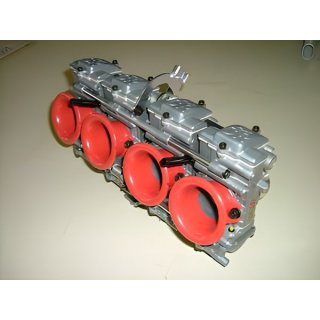 |
 |
| Image: www.bikeside.de | Image: www.mikunioz.com |
As mentioned there seem to be many Keihin CVK carb combinations on the GPz900R- and when you have done any other engine work (eg headers) you will likely need to also adjust the jetting of these.
But since the carbs are likely to be original, they are probably also due for a clean & rebuild even if you are just planning on changing jets. This is because you don’t want any mis-operation of the carb to affect your readings when trying to set up. So that’s more cost, and just removing them also typically means paying for new connecting rubbers so you can *easily* get them back in!
So there is an argument to just buy new flat-side carbs such as the Mikuni RS36 rather than rebuilding your old ones. The FCR’s are simply in another dimension unless you purchase second-hand – and then you probably need to rebuild anyway!
When replacing carbs remember to source those that can be adjusted to fit your original carb body spacings.
Both of these carbs are bigger bodied (so not necessarily better) so provide more scope for further engine performance modifications AND flat-slide carbs are the preferred equipment for professional tuners and track operation. And because they are new everything should be working perfectly so the tuning should be more straight-forward.
The more direct throttle response is arguably desirable for sports riding (I repeat CV carbs are fine!) and these carbs have an accelerator pump feature that suggests a potential improvement in the low to mid range throttle response, both of these would be beneficial to riding the GPz900R. That said if the bike is used for touring, they do not compensate as well as CV carbs for altitude changes and they are expensive.
Nov 2020 prices without shipping (from OS)
- FCR AU$2861 (ouch!) or 2nd hand at auction for AU$933 on www.jauce.com
- RS AU$1091
For the cost of FCR’s you would definitely want a SERIOUS improvement somewhere, the RS are much more in the ballpark and comparable to prices being asked for rebuilt CVK34’s.
In the end I suspect the decision to rebuild or replace will come down to cash-in-hand and your knowledge or experience or desire for more performance.
Lastly, I repeat ad nauseum that the Keihins CVK’s are pretty darn good & more than suitable to accommodate most non-racing performance enhancements like headers.
Updates: a forum owner gave some really interesting insight. CVK slides have ports that create a venturi effect that works along with the spring to close the slide balancing with the vacuum trying to open it. Flat slides only use the spring to close the slide therefore need to be significantly stronger. His opinion is that this makes the throttle twist to heavy for comfortable road riding, so he still recommends CVK’s.
However I have also recently learnt that newer flat-slide carbs employ roller slides to reduce the operating force, so perhaps this isn’t applicable to all. But since we don’t have any cruiuse control even the standard carbs are a PITW (pain-in-the-wrist) when touring, so something definitely worth considering.
Duncan Racing - Tuning
The following link is a comprehensive 10-page PDF from Duncan Racing describing the process of tuning and jetting the Keihin carburetor as well as pointing out several other factors that need to be considered. I have not used the tech sheet and it is simply provided as a potential starting point for your journey if you choose this path!
Switching carbs on the later GPz900R
As mentioned the CVK34 carbs on later bikes (108hp) are not the same as the carbs on the early bikes (115hp). The later carbs clearly draw less air as the airbox intake size is reduced by 50% and they use much smaller main jets.
So it restoring that 7hp as simple as sourcing a bank of ‘old’ carbs?
Maybe, but I wonder if there aren’t some other factors involved, especially given the early bikes ran leaded fuel and the early bikes only have a single cable throttle cable setup – later bikes have two. Not only that, but the early setup was obviously less refined, after all the 2nd gen bikes are only dropping 7hp with much smaller main jets and air intake. Interestingly only the Japanese bikes were factory specified with the largest main jets (#110 = 0.950mm²) for 2nd gen bikes, Europe got #108 and Australia only #105 = 0.866mm².
So for Aussies changing JUST this jet *theoretically* allows 9.7% more fuel to flow at the top end.
This site shows the process of changing carbs, though a bit more detail on the throttle cable issue would have been nice. I’d also be suggesting you would want new airbox-to-carb rubbers to assist with putting it all back together.
Click here to open link in new tab
GPz900r (ZX900) Database
A1 to A4
A5 to A8
A9 to A12
A13 to A16
About the Site
My family loves older vehicles, the newest one we own is 2003! But I am acutely aware of the ownership complexities especially:
- they often need more 'hands-on' mechanical work &;
- there often isn't any local expertise from the service centres;
- there is often no new parts available from the manufacturer;
- parts often have to be sourced 2nd-hand or from overseas.
So we often end up doing a lot of the research & work ourselves and this information gets stored either locally with the bike or online forums - although finding the useful parts in these forums isn't always simple.
The original goal of the site was simply somewhere for me to record service work & contacts on my GPz900r so that my kids (the one that likes bikes anyway!) could easily access it - it doesn't concern me if it was publicly available.
I then realised that with this online structure in place I could also offer it to other owners, and the site could potentially expand to record other owners experiences and expertise , meaning we can learn from others but also pass on this knowledge to subsequent owners of these wonderful motorcycles.
At least Covid-19 has given me plenty of spare time to pursue my passion for the motorcycle!

Location
Adelaide
South Australia
gpz900r@motoshoot.com.au
Timeline
1983 - Honda XR200
1984 - wanted a GPz
1985-2013 - cars+family
2014 - finally got one!
Disclaimer
The information provided on this site (or links) is personal experiences from non-professional home-mechanics, so neither it's accuracy nor it's validity can be confirmed. If you need professional advise please visit your local Kawasaki dealership or a qualified industry professional.
Like riding any motorcycle, at the end of the day the only opinion that really counts is your own!

